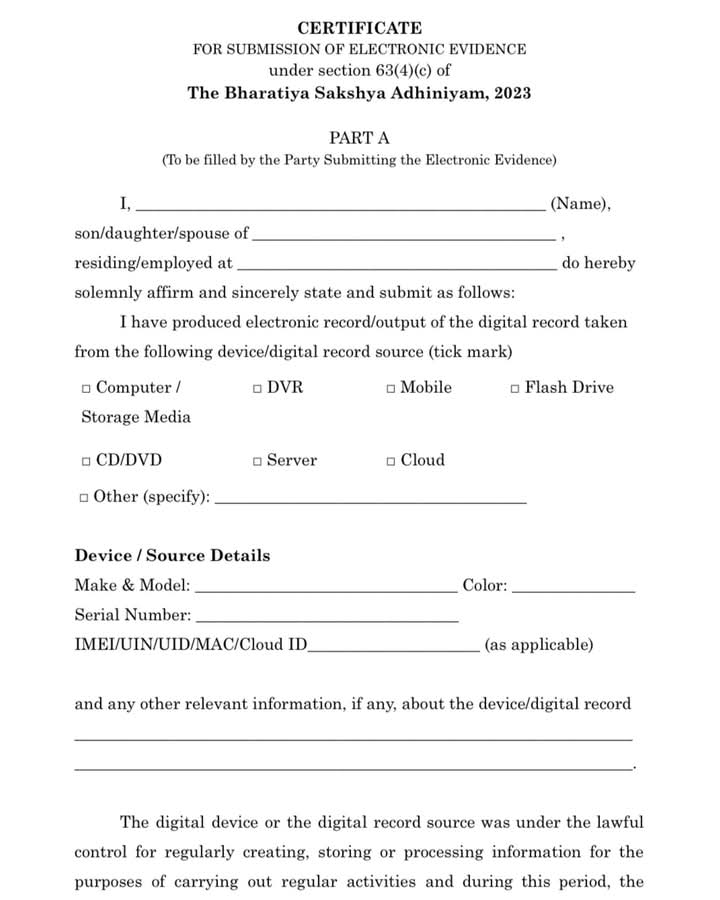Erstwhile 65B (Indian Evidence Act), now 63(4)(c) of BSA, 2023.

Introduction
With the enforcement of the Bharatiya Sakshya Adhiniyam, 2023 (BSA, 2023) replacing the Indian Evidence Act, 1872, one of the most crucial and frequently litigated provisions — Section 65B, dealing with the admissibility of electronic records — has been re-enacted in a modified form as Section 63(4)(c). This blog aims to decode the new provision, understand the rationale behind the change, and explore its implications for practitioners, litigants, and forensic investigators in India.
Historical Context: The Journey of Section 65B
Under the Indian Evidence Act, Section 65B was introduced via the Information Technology Act, 2000, in response to the growing reliance on digital data. It laid down stringent conditions for the admissibility of electronic records, including:
- Production of a certificate under Section 65B(4),
- Specification of the computer and process involved,
- Identification of the person responsible for the operation or control.
This section became the center of numerous landmark judgments — State v. Navjot Sandhu (2005), Anvar P.V. v. P.K. Basheer (2014), and Arjun Panditrao Khotkar v. Kailash Kushanrao Gorantyal (2020) — all of which clarified and at times complicated the requirement of the Section 65B certificate.
The New Regime: Section 63(4)(c) of BSA, 2023
Text of Section 63(4)(c) (Bharatiya Sakshya Adhiniyam, 2023):
“(4) An electronic record shall be said to be also a document, if it is—
(c) accompanied by a certificate identifying the electronic record containing the statement and describing the manner in which it was produced, signed by a person occupying a responsible official position in relation to the operation of the relevant device or the management of the relevant activities.”
Key Changes and Observations:
- Simplified Structuring:
The BSA has condensed the verbose and technical language of 65B into a more readable and structured format in Section 63. - Retained the Certificate Requirement:
The requirement for a certificate identifying the electronic record and how it was produced continues to be mandatory, preserving the safeguards against tampering. - Eased Procedural Rigor:
Compared to the original 65B(4), the new provision omits detailed technical jargon like “regular use,” “inputting,” or “combination of computers.” It focuses on authenticity and chain of custody rather than machinery. - Responsible Person Requirement Continues:
The signatory of the certificate must still hold a “responsible official position”—ensuring accountability and traceability.
Implications for Practitioners
- No More Ambiguity?
While the rephrasing is intended to simplify, the judicial interpretation of Section 63(4)(c) will determine whether it solves the long-standing confusion regarding certificates, especially in third-party data (e.g., CDRs, WhatsApp chats). - Ease for Law Enforcement and Litigants:
Law enforcement agencies may find the less technical language more practical for real-world implementation. However, compliance with the certificate requirement remains mandatory unless exempted by future case law or rules. - Court Challenges Remain Possible:
Disputes may still arise over:- The adequacy of the certificate
- Whether a printout or soft copy is “original”
- Admissibility of server-side data (e.g., Google, Meta)
Judicial Precedents: Do They Still Apply?
The existing judgments under Section 65B may continue to be referred to in interpreting Section 63(4)(c), unless expressly overruled. The principle of certificate being sine qua non, as laid down in Anvar and Arjun Panditrao, will likely remain applicable.
Practical Tips for Lawyers and Litigants
- Always Obtain a Certificate: Whether it’s a mobile phone extract, CCTV footage, or email, ensure that a Section 63(4)(c) certificate accompanies the document.
- Identify the Signatory Properly: Choose someone from the organization or service provider who is authorized and knowledgeable about the system.
- Describe the Process Clearly: The certificate must explain the method of extraction and creation of the record, including software, date, and hardware used.
- Ensure Consistency in Metadata: Any mismatch between the content and metadata can raise doubts and lead to rejection.
Conclusion
The migration from Section 65B to Section 63(4)(c) under the Bharatiya Sakshya Adhiniyam, 2023 reflects India’s effort to modernize and simplify evidence law in a digital-first world. While the spirit of the old law is retained, the new wording aims to reduce interpretational hurdles.
However, the real test lies in judicial application and practical compliance. Until the Hon’ble Supreme Court weighs in on the contours of Section 63(4)(c), practitioners must exercise the same diligence and documentation as under the erstwhile Section 65B.
Suggested Citation:
Subramanian, Sathya Narayanan. “From Section 65B to Section 63(4)(c): The Evolution of Electronic Evidence in Indian Law”. [SathyaNarayanan.in], May 2025.